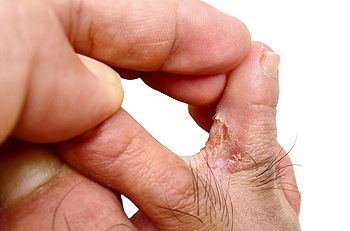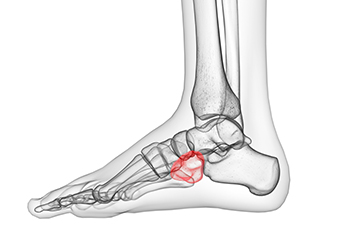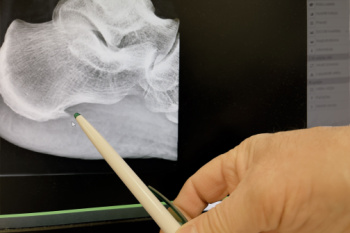
Good foot hygiene helps prevent odor, infection, and common skin problems. Washing your feet daily with soap and water removes sweat, dirt, and bacteria. Drying carefully between the toes helps prevent fungal infections. Keeping toenails trimmed and clean reduces the risk of ingrown nails and infection. Moisturizing dry skin can prevent cracks, especially on the heels. Wearing clean, breathable socks and changing them daily keeps feet dry and comfortable. Shoes should fit well and be allowed to air out between uses. Avoid walking barefoot in public places like locker rooms or near pools, where germs are common. Simple habits make a big difference in keeping your feet healthy. If you notice changes in your skin, nails, or foot odor that does not improve, it is suggested you see a podiatrist for diagnosis and appropriate treatment.
Athlete’s foot is an inconvenient condition that can be easily reduced with the proper treatment. If you have any concerns about your feet and ankles, contact one of our podiatrists from New York Foot and Ankle. Our doctors will treat your foot and ankle needs.
Athlete’s Foot: The Sole Story
Athlete's foot, also known as tinea pedis, can be an extremely contagious foot infection. It is commonly contracted in public changing areas and bathrooms, dormitory style living quarters, around locker rooms and public swimming pools, or anywhere your feet often come into contact with other people.
Solutions to Combat Athlete’s Foot
- Hydrate your feet by using lotion
- Exfoliate
- Buff off nails
- Use of anti-fungal products
- Examine your feet and visit your doctor if any suspicious blisters or cuts develop
Athlete’s foot can cause many irritating symptoms such as dry and flaking skin, itching, and redness. Some more severe symptoms can include bleeding and cracked skin, intense itching and burning, and even pain when walking. In the worst cases, Athlete’s foot can cause blistering as well. Speak to your podiatrist for a better understanding of the different causes of Athlete’s foot, as well as help in determining which treatment options are best for you.
If you have any questions please feel free to contact one of our offices located in Franklin Square, Bethpage, Brooklyn, and Massapequa, NY . We offer the newest diagnostic and treatment technologies for all your foot and ankle needs.

Cuboid syndrome occurs when the cuboid bone in the foot becomes partially dislocated, a situation known as subluxation. The cuboid bone is located on the outer side of the foot, between the heel and the base of the fourth and fifth toes, playing a vital role in stabilizing the foot and supporting movement. Causes of cuboid syndrome include sudden injuries like ankle sprains, repetitive stress from activities like running or jumping, and wearing poorly fitting shoes that place extra pressure on the foot. Symptoms typically involve pain on the outer side of the foot, difficulty walking, tenderness, and swelling. Sometimes the pain can radiate into the toes or up the leg. If you have pain in this part of your foot, it is suggested that you consult a podiatrist who can accurately diagnose and offer treatment options.
Cuboid syndrome, also known as cuboid subluxation, occurs when the joints and ligaments near the cuboid bone in the foot become torn. If you have cuboid syndrome, consult with one of our podiatrists from New York Foot and Ankle. Our doctors will assess your condition and provide you with quality foot and ankle treatment.
Cuboid syndrome is a common cause of lateral foot pain, which is pain on the outside of the foot. The condition may happen suddenly due to an ankle sprain, or it may develop slowly overtime from repetitive tension through the bone and surrounding structures.
Causes
The most common causes of cuboid syndrome include:
- Injury – The most common cause of this ailment is an ankle sprain.
- Repetitive Strain – Tension placed through the peroneus longus muscle from repetitive activities such as jumping and running may cause excessive traction on the bone causing it to sublux.
- Altered Foot Biomechanics – Most people suffering from cuboid subluxation have flat feet.
Symptoms
A common symptom of cuboid syndrome is pain along the outside of the foot which can be felt in the ankle and toes. This pain may create walking difficulties and may cause those with the condition to walk with a limp.
Diagnosis
Diagnosis of cuboid syndrome is often difficult, and it is often misdiagnosed. X-rays, MRIs and CT scans often fail to properly show the cuboid subluxation. Although there isn’t a specific test used to diagnose cuboid syndrome, your podiatrist will usually check if pain is felt while pressing firmly on the cuboid bone of your foot.
Treatment
Just as the range of causes varies widely, so do treatments. Some more common treatments are ice therapy, rest, exercise, taping, and orthotics.
If you have any questions, please feel free to contact one of our offices located in Franklin Square, Bethpage, Brooklyn, and Massapequa, NY . We offer the newest diagnostic and treatment technologies for all your foot care needs.

A heel spur is a bony growth that forms on the underside of the heel bone, often linked with long-term strain on foot muscles and ligaments. It develops when calcium deposits build up over time, creating a pointed projection that can cause heel pain, especially during walking or standing. Heel spurs are commonly associated with plantar fasciitis, a condition involving inflammation of the connective tissue along the bottom of the foot. Diagnosis is typically confirmed through physical examination and imaging studies like X-rays. Contributing causes include repetitive stress from activities like running, wearing unsupportive footwear, or having flat feet or high arches. Risk factors include aging, obesity, and occupations that involve prolonged standing. If you have heel pain, it is suggested that you schedule an appointment with a podiatrist who can accurately diagnose and treat heel spurs.
Heel spurs can be incredibly painful and sometimes may make you unable to participate in physical activities. To get medical care for your heel spurs, contact one of our podiatrists from New York Foot and Ankle. Our doctors will do everything possible to treat your condition.
Heels Spurs
Heel spurs are formed by calcium deposits on the back of the foot where the heel is. This can also be caused by small fragments of bone breaking off one section of the foot, attaching onto the back of the foot. Heel spurs can also be bone growth on the back of the foot and may grow in the direction of the arch of the foot.
Older individuals usually suffer from heel spurs and pain sometimes intensifies with age. One of the main condition's spurs are related to is plantar fasciitis.
Pain
The pain associated with spurs is often because of weight placed on the feet. When someone is walking, their entire weight is concentrated on the feet. Bone spurs then have the tendency to affect other bones and tissues around the foot. As the pain continues, the feet will become tender and sensitive over time.
Treatments
There are many ways to treat heel spurs. If one is suffering from heel spurs in conjunction with pain, there are several methods for healing. Medication, surgery, and herbal care are some options.
If you have any questions feel free to contact one of our offices located in Franklin Square, Bethpage, Brooklyn, and Massapequa, NY . We offer the latest in diagnostic and treatment technology to meet your needs.

Sesamoiditis is an inflammatory condition that affects the small sesamoid bones beneath the big toe joint, often causing pain at the ball of the foot. These bones act like pulleys, helping the tendons move smoothly and bear the stress of walking, running, or jumping. When repetitive pressure or trauma irritates the area, pain can develop beneath the big toe, especially when bending or pushing off the foot. Symptoms of sesamoiditis include swelling, tenderness, and difficulty walking, sometimes leading to a limping gait to avoid pressure on the forefoot. Although sesamoiditis is not life-threatening, it can disrupt daily activities. A podiatrist can confirm the diagnosis, recommend footwear modifications, and may prescribe custom orthotics to relieve pressure on the joint. Further treatment such as immobilization or surgery may be necessary in severe cases. If you are experiencing pain beneath your big toe, it is suggested that you make an appointment with a podiatrist for a diagnosis and treatment.
Sesamoiditis is an unpleasant foot condition characterized by pain in the balls of the feet. If you think you’re struggling with sesamoiditis, contact one of our podiatrists of New York Foot and Ankle. Our doctors will treat your condition thoroughly and effectively.
Sesamoiditis
Sesamoiditis is a condition of the foot that affects the ball of the foot. It is more common in younger people than it is in older people. It can also occur with people who have begun a new exercise program, since their bodies are adjusting to the new physical regimen. Pain may also be caused by the inflammation of tendons surrounding the bones. It is important to seek treatment in its early stages because if you ignore the pain, this condition can lead to more serious problems such as severe irritation and bone fractures.
Causes of Sesamoiditis
- Sudden increase in activity
- Increase in physically strenuous movement without a proper warm up or build up
- Foot structure: those who have smaller, bonier feet or those with a high arch may be more susceptible
Treatment for sesamoiditis is non-invasive and simple. Doctors may recommend a strict rest period where the patient forgoes most physical activity. This will help give the patient time to heal their feet through limited activity. For serious cases, it is best to speak with your doctor to determine a treatment option that will help your specific needs.
If you have any questions please feel free to contact one of our offices located in Franklin Square, Bethpage, Brooklyn, and Massapequa, NY . We offer the newest diagnostic and treatment technologies for all your foot and ankle needs.
